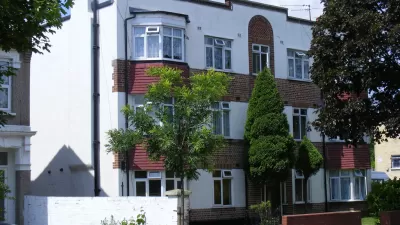A new report from the Urban Land Institute highlights successful strategies for adapting the infrastructure of America's suburbs to accommodate a densification of development.
What infrastructure adjustments will be necessary to adapt America's sprawling suburbs to accommodate the need and desire for more compact growth? This is the subject of a new ULI report, "Shifting Suburbs: Reinventing Infrastructure for Compact Development," which utilizes case studies from eight suburban redevelopment projects to identify the "winning strategies, stumbling blocks, and other lessons learned," in what may be America's most pressing land use challenge.
"America’s suburbs are experiencing a dramatic shift away from the development patterns of previous decades, which were almost entirely car-centric," says Patrick L. Phillips, ULI chief executive officer. "There is an increasing demand, especially among gen Y, for high-density living environments that provide access to more transportation choices. Through Shifting Suburbs, ULI is drawing from some of America’s most innovative suburban redevelopments to share lessons learned about adapting and reusing infrastructure to fit the changing needs of residents. We’re striving to help both private and public sector organizations determine how to plan, fund, and finance the often complicated infrastructure required for successful compact development."
Subjects of case studies include: Bridge Street Corridor in Dublin, Ohio; Aurora Corridor in Shoreline, Washington; Belmar in Lakewood, Colorado; State Route 7 in Broward and Miami-Dade counties, Florida; White Flint/Rockville Pike in Montgomery County, Maryland; Richardson, Texas; CityCentre in Houston, Texas; and West End in St. Louis Park, Minnesota.
FULL STORY: How to Make Suburbs Work Like Cities

Planetizen Federal Action Tracker
A weekly monitor of how Trump’s orders and actions are impacting planners and planning in America.

Restaurant Patios Were a Pandemic Win — Why Were They so Hard to Keep?
Social distancing requirements and changes in travel patterns prompted cities to pilot new uses for street and sidewalk space. Then it got complicated.

Map: Where Senate Republicans Want to Sell Your Public Lands
For public land advocates, the Senate Republicans’ proposal to sell millions of acres of public land in the West is “the biggest fight of their careers.”

Maui's Vacation Rental Debate Turns Ugly
Verbal attacks, misinformation campaigns and fistfights plague a high-stakes debate to convert thousands of vacation rentals into long-term housing.

San Francisco Suspends Traffic Calming Amidst Record Deaths
Citing “a challenging fiscal landscape,” the city will cease the program on the heels of 42 traffic deaths, including 24 pedestrians.

California Homeless Arrests, Citations Spike After Ruling
An investigation reveals that anti-homeless actions increased up to 500% after Grants Pass v. Johnson — even in cities claiming no policy change.
Urban Design for Planners 1: Software Tools
This six-course series explores essential urban design concepts using open source software and equips planners with the tools they need to participate fully in the urban design process.
Planning for Universal Design
Learn the tools for implementing Universal Design in planning regulations.
Heyer Gruel & Associates PA
JM Goldson LLC
Custer County Colorado
City of Camden Redevelopment Agency
City of Astoria
Transportation Research & Education Center (TREC) at Portland State University
Camden Redevelopment Agency
City of Claremont
Municipality of Princeton (NJ)




























